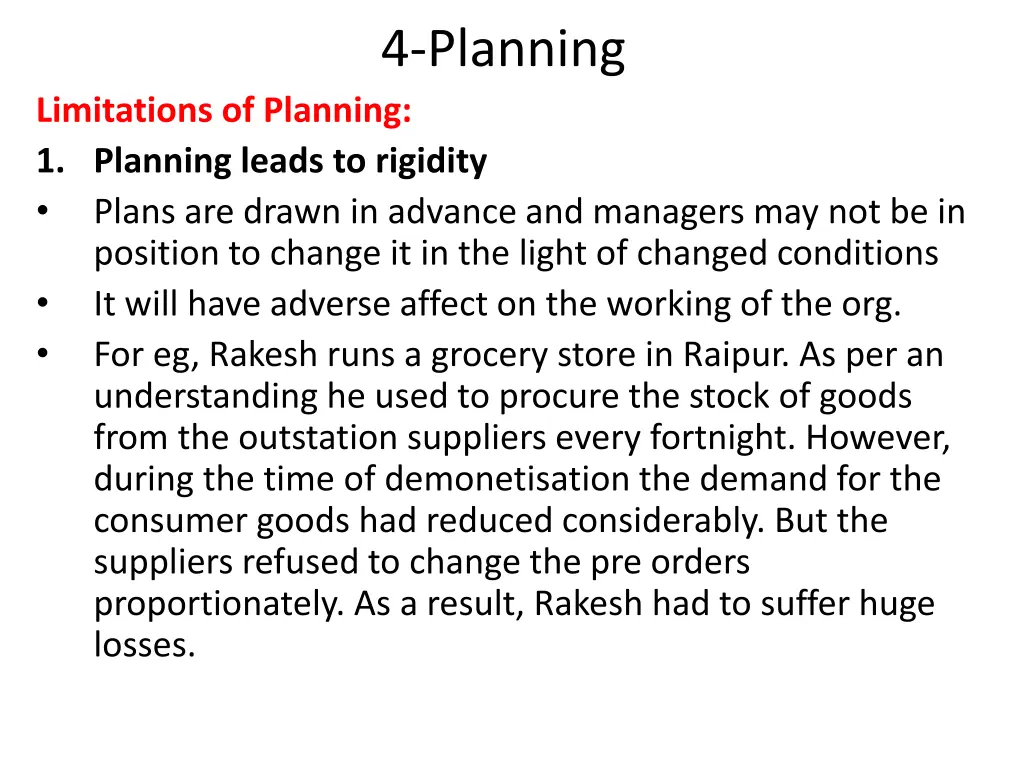
Limitations of Planning in Business Management
Explore the drawbacks of rigid planning in business management, such as reduced adaptability to changing conditions, decreased creativity, high costs, time consumption, and failure to guarantee success. Real-life examples illustrate the importance of flexibility in planning to navigate dynamic environments effectively.
Uploaded on | 0 Views
Download Presentation

Please find below an Image/Link to download the presentation.
The content on the website is provided AS IS for your information and personal use only. It may not be sold, licensed, or shared on other websites without obtaining consent from the author. If you encounter any issues during the download, it is possible that the publisher has removed the file from their server.
You are allowed to download the files provided on this website for personal or commercial use, subject to the condition that they are used lawfully. All files are the property of their respective owners.
The content on the website is provided AS IS for your information and personal use only. It may not be sold, licensed, or shared on other websites without obtaining consent from the author.
E N D
Presentation Transcript
4-Planning Limitations of Planning: 1. Planning leads to rigidity Plans are drawn in advance and managers may not be in position to change it in the light of changed conditions It will have adverse affect on the working of the org. For eg, Rakesh runs a grocery store in Raipur. As per an understanding he used to procure the stock of goods from the outstation suppliers every fortnight. However, during the time of demonetisation the demand for the consumer goods had reduced considerably. But the suppliers refused to change the pre orders proportionately. As a result, Rakesh had to suffer huge losses.
4-Planning Limitations of Planning: 2. Planning may not work in a dynamic environment Due to dynamism, there is always an element of uncertainty in business. Business is affected by multiple dimensions like economic, political, social envionment etc. Therefore, the success of planning depends on the adaptibility of business to constant changes. For eg, The consumer durable sector in Kerala, which accounts for about 10% of the national market with sales of 3,000 crore was badly hit by floods during the peak Onam season. As a result, the retail sales reduced by 40 % leading to unexpected losses for the marketers.
4-Planning Limitations of Planning: 3. Planning reduces creativity If the top managers are planning everything, then the middle level managers will be responsible for implementation. Hence, the middle level managers will not be able to use their own creativity For eg, Madhur joined an export oriented handicraft unit in Jodhpur as production design coordinator. Being very artistic and creative by nature he had thought that this job will provide him with ample of opportunities to exhibit his talent. However, he was very disappointed because he was told that the designs of the handicrafts are only prepared by the Creative Designer Head of the company. He then stopped giving suggestions.
4-Planning Limitations of Planning: 4. Planning involves huge cost It is based on accurate forecasting and rational judgment of the managers. This involves costs of varied types like money spend on research/forecasting, expert advices, expenses on boardroom meetings . 5. Planning is a time consuming process For best plan, managers have to spend a great deal of time in conducting research, analysing data and intepreting results. This leads to less time for implementation of these plannings.
4-Planning Limitations of Planning: 6. Planning does not guarantee success A single plan may not be applicable in another circumstances due to changes. Hence, if managers are adamant to stick to old plans, it will lead to failure in implementation. For eg, Aruna runs fashion jewellery store in a posh market in Chandigarh. Over the years she had been successful in creating an edge over her competitors by adapting innovative sales promotion techniques. Therefore, when her business was threatened once again with an entry of international brand which aimed at opening a large number of stores at strategic locations within the city. But Aruna remained adamant. Consequently, she faced losses in business.
4-Planning Types of Plans: Types of Plans On the Basis of time period On the Basis of Utility Objectives Single Use plans Standing Plans Strategy Policy Procedure Rule Method Budget Programme Policy Budget Method Programme Procedure Project Rule
4-Planning Types of Plans: 1. Objectives Objectives are the goals, aims or purpose that organisations wish to achieve over varying periods of time- Mc Farland Objectives are formulated by top management and focus on the desired position the management will like to reach. Objectives can be of three categories Organisational, departmental and individual objectives Eg- Amul bought White Revolution and made India the largest producer of milk products in the world
4-Planning Types of Plans: 2. Strategy It is the determination of basic long-term goals and objectives of an enterprise and the adoption of the course of action and the allocation of resources necessary to carry out these goals. It is a comprehensive plan and becomes the basis for decision making. For eg, Kerala Tourism has rolled out a 12-point action plan to revive the sector after the happening of devastating floods which include launching aggressive marketing campaigns within the country and abroad, participating in all major domestic and international trade, holding press meets and awareness campaigns in Delhi and all major cities in India and so on.
4-Planning Types of Plans: 3. Policy It is a verbal, written, implied, overall guide setting up boundaries that supply general limits and direction in which managerial action takes place. They are expressed in the form of general statements that guides managerial decision making and action. Policies can be categorised as major policy. For eg, Nestle is committed to reducing sodium in all its foods and beverages by 10% by the year 2020 and help consumers achieve target daily sodium intake level corresponding to recommendations from WHO product policy.
4-Planning Types of Plans: 3. Policy Policies can be categorised as minor policy. For eg, the human resources policies relating to recruitment of an employee, termination, performance appraisal, promotion, pay increases etc.
4-Planning Types of Plans: 4. Methods It contains the prescribed ways in which a particular task is to be carried out in order to realise the predetermined objective. A good method is the one that helps to increase efficiency by saving time, effort and money thereby leading to optimum utilisation of resources. For eg, On-the-job training methods are more appropriate for training employees at middle and lower levels. Off-the-job training methods are suitable for higher level management.
4-Planning Types of Plans: 5. Procedure Procedure prescribes the manner or methods through which work is to be performed. -Allen It contains a series of steps to be performed in a chronological order so as to carry out routine activities within an organisation. For eg, Sales department has made a policy to execute all orders within 24 hours. At the same time, a procedure containing a sequence of steps should be made
4-Planning Types of Plans: 5. Procedure
4-Planning Types of Plans: 6. Budget It is an estimate of future needs, arranged according to an orderly bases, covering some or all of the activities of an enterprise for a definite period of time- George R Terry. It is determined in numerical terms. For eg, a sales budget may forecast the sales of different products in each area for a particular month.
4-Planning Types of Plans: 6. Budget
4-Planning Types of Plans: 7. Rule A rule is a type of plan that requires a specific and definite action with respect to a situation- Koontz O Donnell It is essential for discipline and smooth operations of the business. For eg, No smoking is a rule followed in a factory.
4-Planning Types of Plans: 7. Rule
4-Planning Types of Plans: 8. Programmes Programme are very detailed plans which include an objective, strategy, policy, procedures, rule and method and supported by a budget. It can be categorised as major or minor programme on the basis of its nature and scope. For eg, Literacy programme of the government is major programme and literacy programme of a school is a minor programme.






















